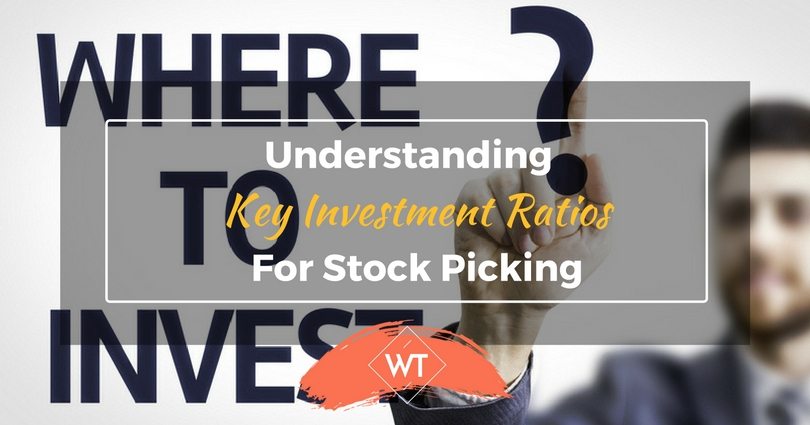Understanding Key Investment Ratios for Stock Picking

Identifying stocks for investment is a complex process because there are thousands of stocks available in the market to choose from. Given the large universe of stocks, its practically not feasible for investors to evaluate all stocks.
The first step towards stock picking strategies is to eliminate a majority of stocks which are not good, too risky or does not suit your investment style.
The second step is to look at key investment ratios and choose the ones which score well on different parameters.
1. Elimination
Hence, the first step is to shortlist or filter stocks so that you have a smaller number to analyze or evaluate. There are a few ways of eliminating stocks which are not suitable based on the following criteria:-
- Sectors which you don’t understand
- High risk sectors
- High political or government influence on industry or its products, pricing, etc. For example oil marketing companies (HPCL, BPCL, etc. ) whose retail pricing is government controlled.
- Companies/Stocks which have not performed well in the last 3 years.
- Stocks which are under influence of scams, frauds, etc.
- Other factors based on your financial planning requirements
2. Analysis of Key Investment Ratios
This makes ratio analysis both a science and an art. Although individual ratios provide a good indicator, these have to be seen in conjunction with other ratios too. For instance a company which has huge sales with small asset base may have an excellent asset turnover ratio (discussed later) but may be taking undue risks by generating credit sales and higher receivables and higher defaults.
Similarly a company which has a good profit margin and decent sales may not be able to generate sufficient net profits because its operating expenses or overheads are too high.
This is where understanding the significance of individual ratios becomes important. I will try to cover a few generic ratios applicable for most companies or industries however you may also want to look at industry specific metrics or ratios.
Price to Earnings Ratio (PE Ratio)
This is one of the most common ratios used for comparing different stocks. Price to Earnings ratio or PE multiple/ratio tries to compare a stock price to its earnings per share.
PE = Market Price per share/Earnings per share (e.g Rs.50/Rs.5 = 10 times)
Implications
Shows whether a company or stock is undervalued or overvalued. A low PE ratio is generally good assuming all other things are constant. However, a high PE could be a positive factor if future growth prospects are excellent.
What is undervalued or overvalued is highly subjective and cannot be decided purely based on the PE multiple.
The easier way to know what is undervalued or overvalued is to compare a company’s PE to the average industry PE. E.g. if the PE of Hindustan Unilever is 31 times you should compare it with average FMCG PE multiple. Assuming average industry PE is 25, then it shows that Hindustan Unilever is overvalued when compared to industry average estimates.
Price to Book Ratio
This ratio compares the stock price to its book value per share (i.e. net worth per share).
PB = Market Price per share/Book Value (Eg. Rs.50/ Rs.20 = 2.5 times)Book Value = (Assets – Liabilities) / no of shares
Implications
Shows whether a company or stock is undervalued or overvalued. A lower ratio indicates that the networth on books is much higher than the market valuation. PB Ratio is more suited for baking and financial services sector. The analysis is more or less similar to PE ratio.
Debt Equity Ratio
This ratio measures the company’s leverage or proportion of debt financing with its equity capital. Generally speaking long term debt is used for this ratio
Debt Equity Ratio = Total Long term Debt / Shareholder Equity (Eg. Rs.2000 crore/Rs.1500 crore = 1.33)
Implications
A debt equity ratio less than one is favorable. When debt equity ratio is more than one it means debt is greater than equity or it indicates that the company is leveraged.
Higher the debt equity ratio, higher the leverage, which means more debt and interest costs, which can eat in to the company’s earnings.
During the late 2008 global crisis real estate firms which had high debt equity ratios were affected severely because over and above the fall in real estate prices, the companies were forced to pay interest costs as high as 25% or over 30%. Those with higher debt equity ratios faced an acute cash crunch and huge losses too.
Asset Turnover Ratio
This ratio tell us how much of sales have been generated for every rupee of assets.
Asset Turnover Ratio = Revenue/Total Assets (Eg. Rs.300 Crore/Rs.200 Crore = 1.5 times)
Implications
A higher ratio implies that the firm is more efficient in using its assets to generate more revenue. In some cases a higher ratio can come at the cost of low margins, which means the company is boosting its sales by selling at lower prices (at reduced profit margins), which will have an impact on profitability.
Return on Capital Employed (ROCE)
As the name implies, this shows the return or profits earned by the company out of its capital employed.
ROCE = Earnings before interest & tax/ (Total Assets – Current Liabilities) (Eg. Rs.90 Crore/Rs.900 Crore = 10%)
Implications
A higher ROCE is better. Increase in ROCE over a period indicates strong performance. ROCE is important for shareholders as well as debenture holders because it takes both debt and equity capital in to consideration.
Return on Net Worth (Return on Equity – ROE)
This shows the return or profits earned by the company out of its capital employed.
ROE = (Earnings after interest, tax and preference dividends)/Ordinary Shareholder’s equity (Eg. Rs.75 Crore/Rs.1000 Crore = 7.5%)
Implications
A higher ROE is favorable. Return on Equity is important from the point of view of ordinary equity shareholders, because their share of profits/earnings is after interest, tax and payment of preference dividends.
Current Ratio/Quick Ratio
This ratio tells you about the ability of the firm to manage its short term financial obligations. Short term obligations are those which are expected to be paid within a year.
Current Ratio = Current Assets/Current Liabilities (Eg. Rs.500 Crore /Rs.400 Crore = 1.25)
Quick Ratio = Quick Assets*/Current Liabilities
* Excludes stock and prepaid expenses
A current ratio of above 1 is considered good, because it shows that the company’s current assets are sufficient to cover its short term liabilities.
A ratio between 1 and 2 is considered good, barring some industry specific variations. A lower current ratio is harmful because it indicates that the company is unable to generate sufficient current assets to cover its short term needs.
Quick ratio is another variant to current ratio, where the numerator includes only quick assets (i.e. excluding stock and prepaid expenses).
Conclusion
Some ratios could help you filter and weed out stocks which are not meeting your criteria. For instance a conservative investor could exclude companies with high debt equity ratio.
Lets say an investor say Mr. Ramesh is looking at established business with strong revenues and profitability, one can choose established companies with a higher asset turnover and ROE. Given the rising interest rate scenario, in order to cut down his risk further Mr. Ramesh can look at companies with low leverage (low debt equity ratio).
Choosing a stock can also be highly complex and subjective like choosing a property. When you buy a home you look at budget, price per SF, location, running cost, amenities and various other factors. There is no single number or factor that can help you decide, instead you need to take a holistic approach.
The same holistic approach needs to be applied when you invest in stocks. If careful selection is made, one can invest for a long term (or for a life time) and earn lifelong rewards like some of the successful investment gurus.









Leave a Reply